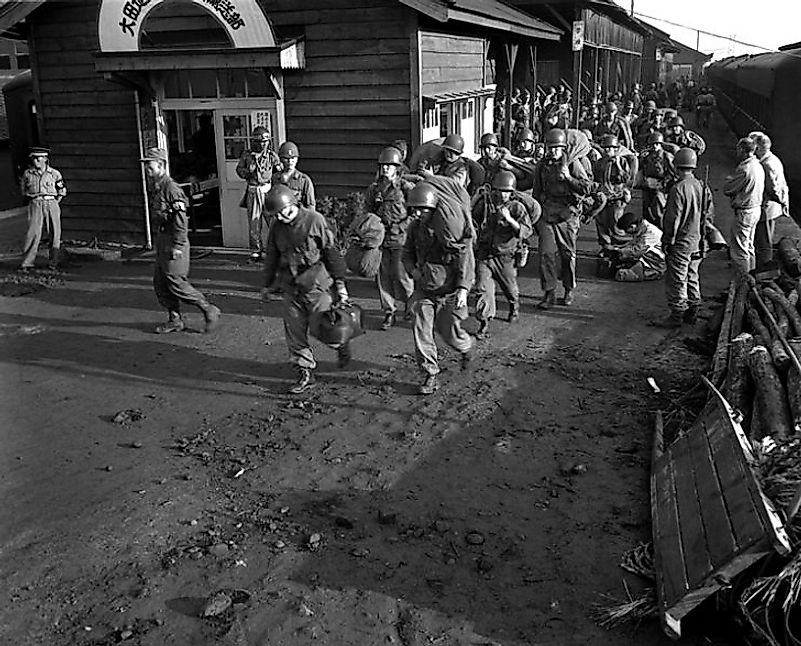The Battle Of Osan - Korean War

5. Background
By 1949, Kim Il-sung, the leader of North Korea, was convinced that a “war of liberation” would be most welcomed by the South Korean people. Discussions with China and Soviet Union went underway and, on the 25th of June, 1950, they finally invaded. The initial full scale invasion involved 89,000 troops. The attack was a massive success, with the North Korean army successfully occupying Seoul only 3 days later. Meanwhile, the United States maintained a non-committal stance. The US was afraid of being embroiled in a land war in Asia with Soviet Union troops, fearing it to easily escalate into World War 3. That changed when the Soviet Union announced that they would not send troops to the Korean Peninsula. The US decided to intervene, mostly out of consideration for Japan.
4. Makeup
The United States’ forces involved at Osan were composed of the 21st Infantry of the 1st Battalion, commanded by Lieutenant Colonel Charles Bradford Smith. Dubbed “Task Force Smith”, the force was under-manned and inadequately equipped, with most of their weapons obsolete. In contrast, the North Korean side in the battle was led by Major General Lee Kwon Mu, and was constituted by the 16th and 18th Regiments of the 4th Infantry Division, with the 105th Armored Regiment and 107th Tank Regiment as support. All told, the Communists had around 5,000 men along with 36 T-34/85 tanks, while the United States only had 540 troops, equipped with obsolete artillery incapable of penetrating tank armor.
3. Description
On July 5th, at 0730 hours, U.S. reconnaissance spotted 8 T34 tanks in a column heading directly toward Task Force Smith's position. 45 minutes later, Task Force Smith fired their howitzer at the incoming forces. The tanks were successfully hit, but weren't damaged by the barrage. Succeeding attempts by the U.S. forces to destroy the tanks, using 75-millimeter recoilless rifles and rocket launchers at close range, did not penetrate the North Korean armor. Later attempts, using High-explosive anti-tank warheads (HEAT), were far more successful, damaging two tanks and setting another on fire. Another group of 25 T-34 tanks approached an hour later and destroyed the forward howitzer. Both tank columns passed on. At 1100 hours a 5,000 troop military convoy under Major General Lee Kwon Mu began advancing southward. 45 minutes later, Smith ordered his entire task force to fire all its weapon at the enemy. Several Trucks were destroyed in the process, scattering the North Korean convoy. The North Korean forces responded by fielding the 3 tanks towards Smith’s position, resulting in 1,000 troops encircling them from their rear flank.
2. Outcome
Smith's forces managed to hold on for a commendable time considered their size, but ultimately they finally retreated after 3 hours. The retreat was a disaster. Smith called for an orderly retreat, but B Company didn't get the order and was left isolated among enemy forces. Most was able to successfully escape but the wounded were left behind along with a medic, which were later found executed by North Korean forces. All told, Task Force Smith lost 40% of its troops, with 21 wounded, 60 dead, 82 captured. Most of the dead were found in shallow graves, their hand tied behind their backs and shot in the head. Meanwhile, the North Korean army suffered the loss of 4 tanks along 85 wounded and 42 dead among their troops.
1. Significance
The Battle of Osan was the first engagement between the United States and the North Korean Army. The fight showed how unprepared and poorly equipped the United States forces were for the war to come. American forces, lacking adequate training and equipment, prematurely abandoned their position worsening the situation. Nevertheless, the American forces were successful in temporarily delaying the North Korean army units they encountered on that day. The delaying tactics by the United States helped prevent Pusan from being successfully overrun earlier, allowing MacArthur's X-Corps to link up with the 8th Army. The delay would ultimately contribute to the successful United Nations landings at Inchon, and the subsequent driving of North Korean forces out of the South. A memorial stands to this day at Osan, commemorating the brave men of Task Force Smith who served there on July 5th, 1950.











